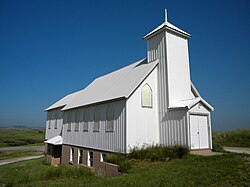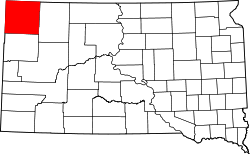History
The Battle of Slim Buttes occurred here on September 9–10, 1876, in the Great Sioux Reservation between the United States Army and Miniconjou Sioux during the Great Sioux War of 1876. It marked the first significant victory for the Army since the stunning defeat of General George Custer at the Battle of Little Bighorn in June.
One hundred fifty troopers led by Captain Anson Mills from the 3rd U.S. Cavalry surrounded the village of thirty-seven lodges and attacked it the next morning, shooting anyone who resisted. Taken by surprise, the Native Americans fled, with a mortally wounded Chief American Horse the elder and fifteen women and children hiding in a nearby ravine/draw. Having refused treatment by the army surgeons after surrendering, American Horse eventually lost his life, as well as two women and one child. One tribal boy was found alive in the village, having slept through the initial fighting. Those Sioux who escaped spread the word to neighboring Sans Arc, Brulé and Cheyenne villages, telling Crazy Horse and other leaders that they had encountered 100-150 soldiers. Unknown to them, Crook's main column of infantry, artillery, and other cavalry had their arrival. [3]
This page is based on this
Wikipedia article Text is available under the
CC BY-SA 4.0 license; additional terms may apply.
Images, videos and audio are available under their respective licenses.



